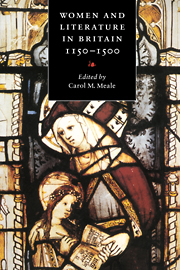Book contents
- Frontmatter
- Contents
- List of illustrations
- List of abbreviations
- Chronology: women and literature in Britain, 1150–1500
- Introduction
- 1 The power and the weakness of women in Anglo-Norman romance
- 2 Women as lovers in early English romance
- 3 Mothers in Middle English romance
- 4 ‘Clerc u lai, muïne u dame’: women and Anglo-Norman hagiography in the twelfth and thirteenth centuries
- 5 Women in No Man's Land: English recluses and the development of vernacular literature in the twelfth and thirteenth centuries
- 6 ‘Women talking about the things of God’: a late medieval sub-culture
- 7 ‘… alle the bokes that I haue of latyn, englisch, and frensch’: laywomen and their books in late medieval England
- 8 Women authors and women's literacy in fourteenth- and fifteenth-century England
- 9 Women and their poetry in medieval Wales
- Further reading
- Index of manuscripts
- Index of names and titles
3 - Mothers in Middle English romance
Published online by Cambridge University Press: 09 November 2009
- Frontmatter
- Contents
- List of illustrations
- List of abbreviations
- Chronology: women and literature in Britain, 1150–1500
- Introduction
- 1 The power and the weakness of women in Anglo-Norman romance
- 2 Women as lovers in early English romance
- 3 Mothers in Middle English romance
- 4 ‘Clerc u lai, muïne u dame’: women and Anglo-Norman hagiography in the twelfth and thirteenth centuries
- 5 Women in No Man's Land: English recluses and the development of vernacular literature in the twelfth and thirteenth centuries
- 6 ‘Women talking about the things of God’: a late medieval sub-culture
- 7 ‘… alle the bokes that I haue of latyn, englisch, and frensch’: laywomen and their books in late medieval England
- 8 Women authors and women's literacy in fourteenth- and fifteenth-century England
- 9 Women and their poetry in medieval Wales
- Further reading
- Index of manuscripts
- Index of names and titles
Summary
The relationship between mothers and their children is one which has received surprisingly little explicit literary treatment even in a post-Freudian age so acutely conscious of its crucial formative importance. Issues of familial relationships, however, inform the underlying structure of many folk– and fairy-tales, as the late Bruno Bettelheim in particular has demonstrated, and at this less than fully articulated, less than fully conscious level are common to the literatures of all ages and of all cultures.
While at first sight Middle English romance appears to have rather little to say about parent–child relationships, on closer examination a preoccupation with such issues will be seen to constitute an important element determining the underlying structure of many of these narratives. In this respect they are akin to traditional stories, with which they also share many surface motifs. My purpose in this essay is to examine the attitudes towards mothers and motherhood either implicit or explicit in the Middle English romances and, by viewing them in relation to attitudes to the maternal role expressed in non-narrative medieval literature, to try to determine how far a distinctively medieval view of motherhood can be inferred from the way in which the romances handle traditional motifs and story-patterns.
Perhaps the most extreme expression of medieval ambivalence towards motherhood comes, somewhat ironically, from the pen of a woman. In the sixtieth chapter of her Revelation, Julian of Norwich writes:
Thys feyer louely worde: Moder, it is so swete and so kynde in it selfe that it may not verely be seyde of none ne to none but of hym and to hym that is very mother of lyfe and of alle. […]
- Type
- Chapter
- Information
- Women and Literature in Britain, 1150–1500 , pp. 41 - 60Publisher: Cambridge University PressPrint publication year: 1993
- 1
- Cited by



